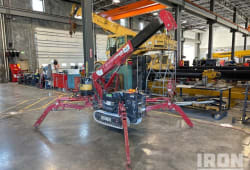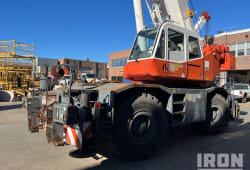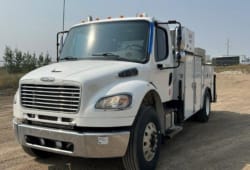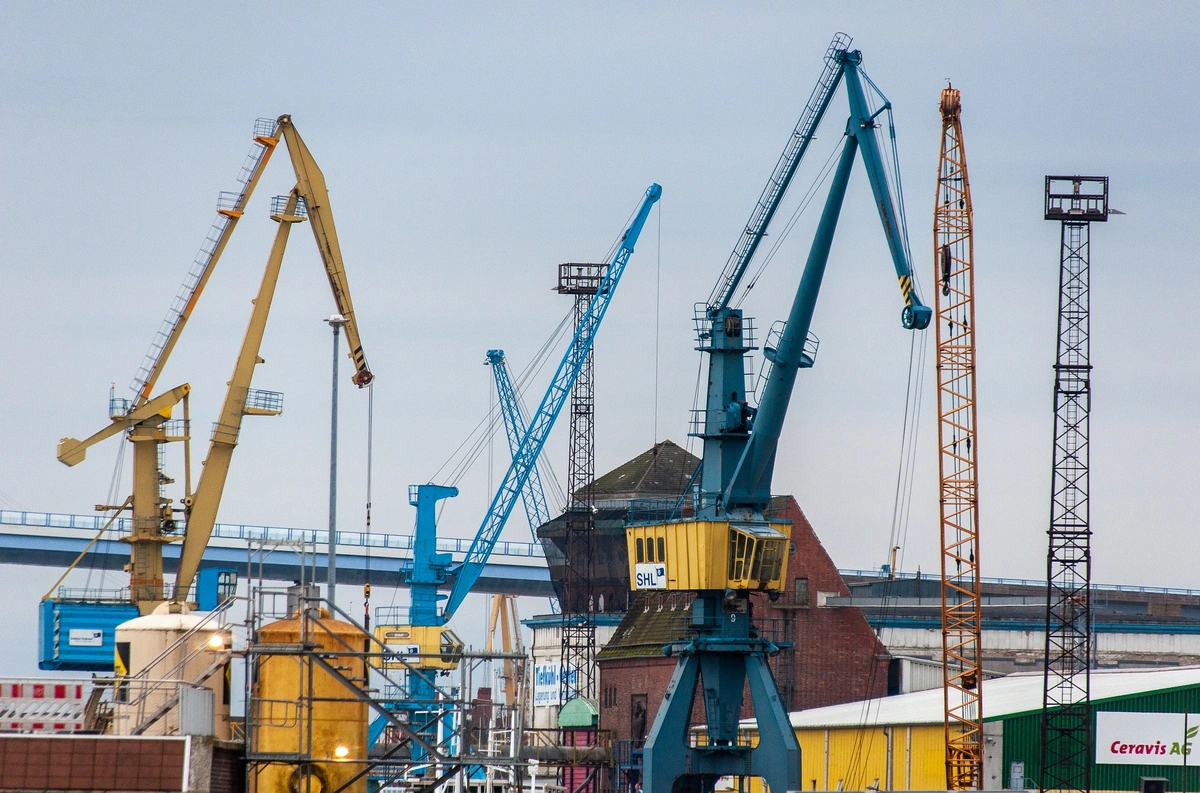Techniques How Cranes are Built and its Parts
13 Lectura mínima
)
mayo 3, 2024
Crane machines are mechanical devices used in construction, manufacturing, and shipping industries to lift, lower, and move heavy or bulky loads. They are essential tools in many projects, allowing for the efficient handling of materials that would otherwise require immense human labor or be impossible to move.
Here are the parts of the crane:
Base:
The base serves as the foundational element of a crane, crucial for supporting the entire structure's weight and operational forces. In mobile cranes, the base typically comprises the truck or vehicle chassis, which includes the engine and the operator's cab. For tower cranes, the base is usually a substantial concrete slab or a deeply embedded foundation that ensures stability and support, especially when lifting heavy loads at significant heights.
Mast (Tower):
The mast, or tower, is a pivotal vertical component that gives the crane its height, essential for accessing high or hard-to-reach areas in construction projects. It is constructed from connected sections that can be pieced together to extend the crane's height as the building project progresses. This modularity allows for flexibility in adapting the crane's height to the specific needs of various construction sites.
Boom:
:format(webp)) The boom is the primary lifting component of a crane, designed to reach outward and upward to lift loads to considerable heights. Booms can be telescopic, allowing them to extend to various lengths; fixed, providing a constant length; or hinged, which offers different angles for complex lifting operations. On mobile and crawler cranes, the boom's design is critical for providing the reach and versatility needed for diverse lifting tasks.
The boom is the primary lifting component of a crane, designed to reach outward and upward to lift loads to considerable heights. Booms can be telescopic, allowing them to extend to various lengths; fixed, providing a constant length; or hinged, which offers different angles for complex lifting operations. On mobile and crawler cranes, the boom's design is critical for providing the reach and versatility needed for diverse lifting tasks.
Jib:
A jib is an extension of the boom that offers additional lifting range, crucial for tasks requiring extended reach beyond the capabilities of the boom alone. Jibs can be fixed or adjustable and are particularly useful in tight spaces or when precise positioning of the load is necessary. In tower cranes, the jib projects horizontally and is often used to swing loads to their intended positions.
Counterweights:
Counterweights are essential for maintaining a crane's balance and stability. Located on the crane’s rear, they help counterbalance the load being lifted, which is vital for preventing the crane from tipping over during operations. The correct calculation and placement of counterweights are crucial for safe crane operation.
Hoist:
The hoist mechanism is responsible for the vertical lifting and lowering of the load. It includes a motor, which powers a drum that winds and unwinds a wire rope or chain attached to the load. This component is fundamental to the crane's operation, requiring precise control to handle heavy loads safely.
Hook:
The hook is attached to the end of the hoist and is the component that directly attaches to the load. Designed to swivel and constructed from high-strength materials, the hook must securely hold various types of cargo without risk of detachment or failure during lifting operations.
Wire Rope:
Wire ropes are critical for the lifting process, made from twisted strands of metal wires that provide strength and flexibility. These ropes run through the crane, over drums, and pulleys, transferring the mechanical force from the hoist to lift or lower the load efficiently and safely.
Outriggers:
Outriggers are extendable parts of mobile cranes that significantly increase the base area, enhancing stability during lifts. Deployed both horizontally and vertically, these supports prevent the crane from tipping by distributing the weight of the load more evenly across a broader base.
Operator’s Cab:
The operator’s cab is the control center of the crane, where the operator manipulates various crane movements. Equipped with multiple controls and instrumentation, the cab allows for precise manipulation of the boom, hoist, and often the crane's rotational movement, ensuring effective and safe handling of loads.
Slewing Unit:
The slewing unit, a turntable bearing located at the top of the mast in tower cranes and near the base in mobile cranes, enables the crane to rotate around a fixed axis. This rotation is crucial for positioning the crane during lifting operations, allowing the operator to move loads horizontally around the crane's central axis.
Building a Crane
Building a crane, especially a large construction crane, is a complex engineering project involving precision manufacturing, skilled assembly, and rigorous testing. The process varies depending on the type of crane, but here’s a general overview of how large construction cranes like tower cranes and mobile cranes are built:
Design and Engineering
Concept and Design: The process starts with identifying the needs of the market or a specific client. Engineers design the crane using computer-aided design (CAD) software to create detailed blueprints and specifications.
Engineering Analysis: This step involves simulations and calculations to ensure the crane can handle specified loads safely under various conditions. Factors such as wind, weight distribution, and mechanical stresses are analyzed.
Manufacturing Components
Steel Fabrication:
The manufacturing of a crane begins with the steel fabrication of its core structural components, including the mast, jib, and boom. These crucial parts are crafted from high-strength steel, chosen for its durability and capacity to withstand the substantial stresses of lifting heavy loads. The fabrication process involves precision cutting, bending, and welding techniques to achieve the exact dimensions and shapes required for structural integrity. Each piece undergoes rigorous quality checks to ensure it meets strict industry standards, contributing to the overall safety and functionality of the crane
Machining:
Following steel fabrication, specific crane parts such as gears, axles, and other critical mechanical components are produced through machining. This process utilizes lathes, mills, and advanced CNC machines to carve metal with exceptional precision. Machining is crucial for creating components that require tight tolerances and complex geometries, ensuring that all parts fit together flawlessly and function smoothly when assembled. The precision in this step is vital for the crane's reliability and efficient operation.
Assembly of Subcomponents:
The assembly process involves putting together various smaller components that make up the crane's operational systems, such as the hoist, slewing unit, and operator's cab. Each subcomponent is assembled with meticulous attention to detail, integrating electrical systems, motors, and control mechanisms. The assembly of these subcomponents is typically done in a controlled factory setting to ensure optimal conditions for safety and quality. Technicians skilled in electrical engineering and mechanical assembly work collaboratively to install and test each component, guaranteeing that the crane operates seamlessly and responds accurately to control inputs.
Assembly and Testing
Initial Assembly:
The construction of a crane begins with the initial assembly of its large components at the manufacturing facility. This crucial phase ensures that each part-such as the mast, boom, and jib-fits together properly and functions as designed. Engineers and technicians meticulously assemble these components, checking alignments and connections for precision. This stage often includes partial testing of mechanical functions to identify any issues early, allowing for adjustments before the crane is considered ready for field deployment.
Painting and Finishing:
After the initial assembly, crane parts undergo a thorough painting and finishing process. This step is vital for protecting the steel and other materials from corrosion, particularly for cranes that will operate in harsh environmental conditions like marine or industrial sites. Specialized coatings and treatments are applied to enhance the crane's resistance to rust and wear, extending its operational lifespan and maintaining its structural integrity.
Disassembly for Shipping:
Once painting and finishing are complete, the crane is carefully disassembled into major sections that are manageable for transportation. This disassembly process is conducted with great care to ensure that no components are damaged, and that reassembly can be carried out efficiently on site. Each part is labeled and packed with protection in mind, facilitating safe and organized transport to the crane’s final destination.
Final Assembly on Site:
Upon arrival at the construction site or client's location, the crane undergoes final assembly. This task is performed by skilled technicians who reassemble the crane according to strict specifications, ensuring every component is securely fastened and fully functional. For tower cranes, this includes anchoring the base to a solid foundation, methodically building the mast from the ground up, attaching the jib, and precisely installing the necessary counterweights for balance and stability.
Testing:
The fully assembled crane is then subjected to a series of rigorous tests to confirm its operational safety and effectiveness. This includes load testing, where the crane must lift weights heavier than its designated capacity, to simulate the stresses it will encounter during normal operations. This testing phase is critical to validate the crane’s performance under actual working conditions and to identify any potential issues that could compromise safety.
Certification:
After successfully passing all functional and safety tests, the crane is certified for operational use by the appropriate authorities or certifying bodies. This certification process ensures that the crane meets all relevant safety and quality standards, providing reassurance that it is fully prepared for commercial or industrial tasks. The certification also serves as a formal acknowledgment that the crane is compliant with industry regulations and ready for safe deployment in field operations.
Maintenance and Training
Operator Training:
Operator training is a crucial component of crane operations, focusing extensively on ensuring that operators are well-versed in the specific model of crane they will be using. This training encompasses not only the basic operation of the crane but also emphasizes safety protocols, effective troubleshooting, and emergency response techniques. Operators learn through both theoretical classes and practical hands-on sessions, which may include simulations and on-site guidance. This comprehensive approach ensures that operators can handle the crane safely and efficiently under various conditions and are prepared to manage potential issues that may arise during crane operations.
Maintenance Programs:
Regular maintenance is essential to ensure that cranes operate reliably and have a prolonged operational life. Maintenance programs are systematically developed to include routine checks and preventive maintenance tasks, which help in identifying and addressing issues before they lead to failures or accidents. These programs often cover inspections of mechanical, electrical, and hydraulic systems; lubrication of moving parts; and checks for structural integrity, including the examination of bolts, cables, and other critical components. Maintenance schedules are typically based on manufacturer recommendations, usage frequency, and environmental factors affecting the crane.
Building a crane is a meticulous process that requires the collaboration of experts in various fields of engineering and manufacturing, ensuring that the final product is safe, efficient, and capable of performing heavy lifting tasks in construction and other industries.
Lifting Process
Load Attachment:
The lifting operation begins with securely attaching the load to the crane’s hook. This crucial step involves using slings, chains, or cables that are carefully selected based on the load's weight and balance requirements. The attachment must be checked thoroughly to ensure that it is secure and correctly positioned to prevent any slippage or imbalance during the lift.
Hoisting:
Once the load is securely attached, the crane operator uses the controls within the cab to raise or lower the load by adjusting the wire rope or cable. This action is performed carefully to maintain stability and control of the load. The hoist mechanism is critical for precisely managing the vertical movement of the load, ensuring it is moved smoothly to avoid any sudden shifts that could lead to damage or accidents.
Trolley Adjustment:
The trolley, which runs along the jib of the crane, is adjusted by the operator to position the load accurately. Moving the trolley closer to the mast increases the crane’s capacity to handle heavier loads by reducing the torque exerted on the crane’s structure. This adjustment is essential for balancing the load within the crane’s operational limits, especially when handling particularly heavy or awkwardly shaped items.
Slewing:
Slewing refers to the crane’s rotation around its vertical axis, which allows the load to be moved horizontally around the construction site. This movement is crucial for positioning the load over the intended area. The crane's slewing unit, equipped with large bearings and motors, enables smooth and controlled rotation, providing the operator with the ability to fine-tune the placement of the load.
Positioning the Load:
During this phase, the operator combines hoisting, trolley adjustments, and slewing to maneuver the load into the exact desired location. This requires skill and precision, as the operator must coordinate these movements to place the load safely and accurately, often in tight or complex environments.
Lowering and Detachment:
Once the load is correctly positioned, it is carefully lowered to the destination. After the load is securely placed, it is detached from the hook. This final step involves reversing the attachment process, ensuring that the load is stable and supported independently of the crane before disengaging the lifting attachments. The detachment must be handled with care to prevent any sudden release that could destabilize the load.
Safety and Efficiency Considerations
Load Limits:
Every crane is engineered with a specific maximum load capacity, which is crucial for maintaining balance and structural integrity during operation. This load capacity can vary based on the boom's angle and the distance of the load from the mast. As the load moves further from the mast, the crane’s ability to balance the load safely decreases, increasing the risk of tipping. Operators must strictly adhere to these load limits, which are typically monitored using load moment indicators that provide real-time data on the weight being lifted and the crane’s stability. This vigilant monitoring helps prevent overloading and ensures that all lifting operations remain within safe operational parameters.
Wind and Weather:
Crane operations are highly susceptible to environmental conditions, particularly wind, which can significantly impact the crane's stability and the safe movement of loads. High winds can sway lifted loads, creating potentially dangerous situations. Consequently, cranes are equipped with anemometers to measure wind speeds continuously, and operations are often paused or adjusted based on these readings. Besides wind, other weather conditions like rain, snow, and extreme temperatures can also affect crane functionality and safety. Operators are trained to respond to these conditions by adjusting lifting strategies or halting operations to ensure safety.
Operator Skill and Communication:
The skill and experience of the crane operator are paramount to the safe and efficient use of the crane. Operators receive comprehensive training on the specific model of crane they will be using, focusing on operational techniques, safety protocols, and emergency procedures. Additionally, clear and continuous communication between the crane operator and the ground team is essential to coordinate movements and address any issues that may arise during operations. This teamwork is facilitated by using radios, hand signals, or other communication devices that help maintain a clear line of communication, ensuring that every lift is conducted safely and efficiently.
Here is where you can have excellent working and various types of crane!

Javier Bocanegra is Boom & Bucket's Technical Resolutions Lead, drawing on 10+ years in automotive and heavy equipment to diagnose issues, resolve complex post-sale cases, and keep machines - and customers - running smoothly. A certified heavy-equipment specialist, he's known for meticulous inspections and hands-on expertise across mechanical, electrical, and hydraulic systems. Based in Sacramento, Javier partners closely with buyers, vendors, and our field teams to deliver reliable outcomes and uphold our standards for safety and trust.














